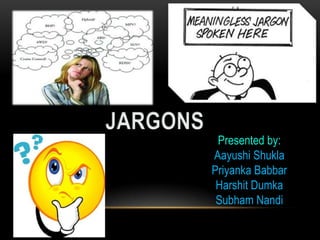
Jargons
- 1. Presented by: Aayushi Shukla Priyanka Babbar Harshit Dumka Subham Nandi
- 2. WHAT IS A JARGON? • A Jargon is characteristic language of particular group, profession or event. • The word comes from Old French jargon meaning “chatter of birds”. • One who studies Jargons is called a Jargonaut.
- 3. WHO USES JARGON? • Commonly used by groups having similar interests like trades and professions • Used by people involved in sports or other casual groups • Also found to be used in medical or law professions.
- 4. USES AND ABUSES OF JARGON • Describes the world in which we live. • Using jargon is fun and gives a sense of belonging to a specific group • Jargons can give a feeling of being excluded from a conversation • Jargons are addictive
- 5. BINOMIAL NOMENCLATURE • Formal system of naming species of living things. • It is a terminology that is used only by a group of people who are into biological studies and therefore fall into jargon category. • The names are made of two parts. • The first part of names are derived from mainly Latin language. • It can also be derived from Greek and other languages, name of a person, place etc. • The second part of the names may be an adjective or a noun.
- 6. CHEMICAL NOMENCLATURE • Set of rules to generate systematic names for chemical compounds. • Developed by the International Union of Pure and Applied Chemistry (IUPAC). • The chemical nomenclature is used to ensure that there is no ambiguity in the name of a specific chemical compound and refers to a single substance. • The name also conveys some information about the structure or chemistry of a compound, which helps in its identification.
- 7. EXAMPLES BIONOMIAL NOMENCLATURE CHEMICAL NOMENCLATURE Erythroxylum coca – Phosphorus pentachloride- it Erythroxylum derived fom has 1 phosphorus and 5 greek word erythros meaning red clorines. Represented as and coca meaning wood PCL5 Panthera leo – where leo is a Dinitrogen tetrachloride – it noun next to the genus name has 2 nitrogen and 4 oxygen Panthera molecules. Represented as N2O 5
- 8. CORPORATE JARGONS Corporate jargon is the jargon often used in large corporations and other bureaucracies. It may be characterised by sometimes-unwieldy elaborations of common English phrases, acting to conceal the real meaning of what is being said.
- 9. EXAMPLES OF CORPORATE JARGONS 24*7 CxO- C-chief, O-Officer USP- Unique Selling Proposition/Point
- 10. Do we really need corporate jargons? “Although much maligned, jargon does have a place in the well- spoken executive’s vocabulary when it is used effectively to create a deeper level of understanding and trust. Particular words and phrases can become unique shorthand among colleagues within the same industry, company, or team. The key is to use the right words for the right audience in an environment that encourages others to press for clarity when the language is unclear.” - Gwen Morgan (a famous Jargonaut)